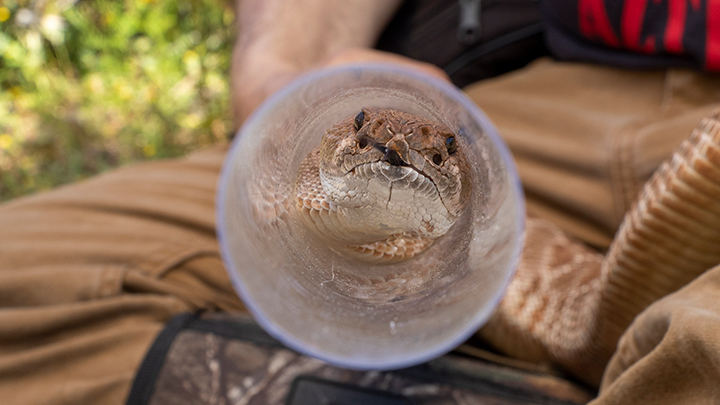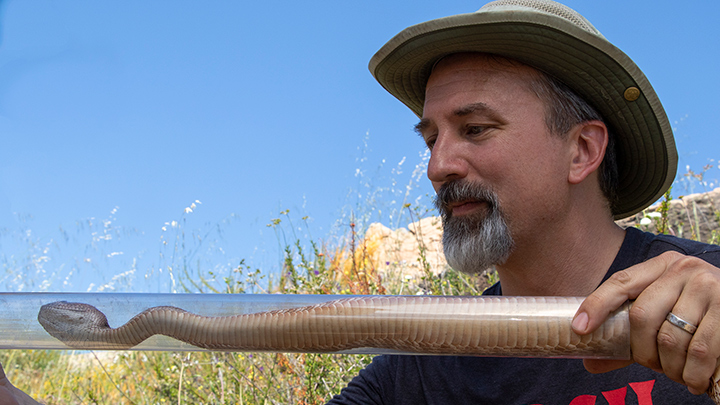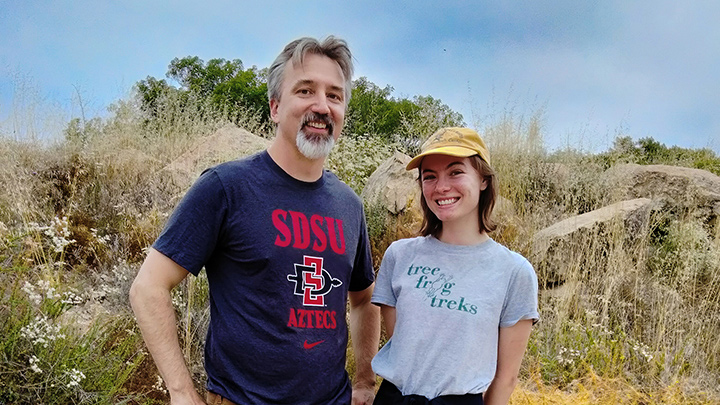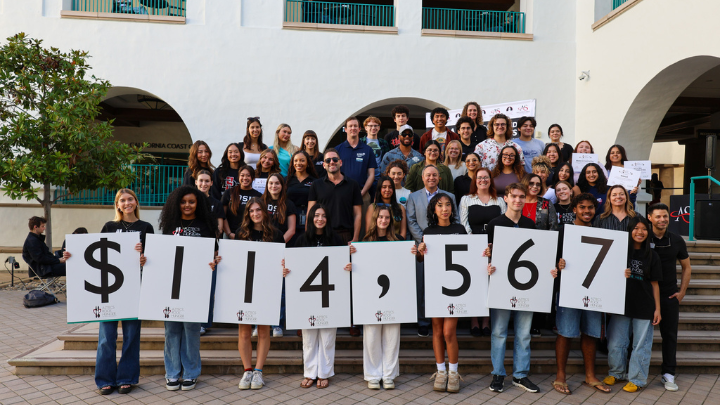SDSU, San Diego Zoo Wildlife Alliance join forces to track rattlesnakes
Using acceleration technology and machine learning tools, the team monitors snake behaviors as part of conservation effort.

San Diego State University and San Diego Zoo Wildlife Alliance (SDZWA) are joining forces to usher in a new way of studying snakes. In a collaboration between SDSU professor of biology Rulon Clark and SDZWA, biologists are tagging wild rattlesnakes with external transmitters and accelerometers.
Previously, telemetry devices on snakes had to be surgically implanted — severely limiting this area of study. SDSU and SDZWA are among the first to use acceleration technology to study snakes.
The research program focuses on red diamond rattlesnakes in the biodiversity reserve at the San Diego Zoo Safari Park. Rattlesnake movement and behavior have historically been difficult to study, and up until now, it hasn’t been possible to know what wild snakes are doing at all times.
Rattlesnakes spend the majority of their time sitting still to evade predators or to ambush prey, and direct human observation interferes with their natural behaviors.
 Biology professor Rulon Clark examines a red diamond rattlesnake. (San Diego Zoo Wildlife Alliance)Mounting small cameras in native habitats allows researchers to indirectly monitor the behavior of a snake, but SDSU and SDZWA have taken it a step further by implementing state-of-the-art technologies in new ways for a full-picture view.
Biology professor Rulon Clark examines a red diamond rattlesnake. (San Diego Zoo Wildlife Alliance)Mounting small cameras in native habitats allows researchers to indirectly monitor the behavior of a snake, but SDSU and SDZWA have taken it a step further by implementing state-of-the-art technologies in new ways for a full-picture view.
“Beyond being incredibly fascinating and dynamic, red diamond rattlesnakes are critical to the health of the ecosystem,” said Jeff Lemm, conservation program specialist at SDZWA. “They have one of the smallest ranges of any rattlesnake in the United States, but the biodiversity reserve at the San Diego Zoo Safari Park is a hotspot for this species. It was a natural progression to tap into the expertise of San Diego State University and Rulon Clark’s lab to take this research to the next level.”
Non-invasive transmitters are attached to the base of the snake’s rattle with a small amount of glue and thread, and accelerometers specially designed for snakes are placed externally, near the neck. The transmitters allow researchers to track an individual snake’s location at different times throughout the year.
The accelerometers — similar to the technology found in cell phones — measure direction and speed, gathering 75 data points every second to create a continual, three-dimensional acceleration trace. The discrete devices do not impact snake behavior — and each device will fall off over time and be recovered by the researchers, so there is no harm to the environment.
Machine learning technology is used to analyze the acceleration data patterns and videos of verified snake behavior, and then recreates the behavioral profile of the snake when it is not being monitored.
The long-term goal of the project is to build a “comprehensive, fine-scale behavioral data set from this very important species so we can understand its ecological relationship to other animals in the environment and their relationship to each other, and other important things about its conservation and ecology,” said Clark.
“I call this a next-generation natural history approach,” he added. “We’re taking some of these recently developed technologies for ecology and behavior, and applying it to this type of animal. The accelerometry technology is transforming our ability to understand what animals are doing when it’s impossible for us to be able to see those animals. It allows us to understand what’s happening even in the absence of direct observation.”
Many species of snakes are facing threats in their native range, including habitat fragmentation and destruction. Vehicle strikes during road crossings are among the leading causes of death — particularly for rattlesnakes in Southern California.
Previous studies have shown there are genetic differences between snake populations on different sides of a freeway. By understanding rattlesnake behavior, scientists hope to use the data to help inform corrective action, including determining whether wildlife overpasses would benefit local snake species.
The biodiversity reserve at the San Diego Zoo Safari Park, with its large expanses of endangered coastal sage scrub vegetation, provides an unparalleled opportunity for scientific study and the development of monitoring and management techniques.
 SDSU Biology professor Rulon Clark and master's student Emma McAndrews at San Diego Zoo Safari Park biodiversity reserve. (Susanne Clara Bard/SDSU)The reserve forms a key part of the larger system of interconnected, protected areas designated to conserve San Diego County’s unique regional biodiversity over the long term.
SDSU Biology professor Rulon Clark and master's student Emma McAndrews at San Diego Zoo Safari Park biodiversity reserve. (Susanne Clara Bard/SDSU)The reserve forms a key part of the larger system of interconnected, protected areas designated to conserve San Diego County’s unique regional biodiversity over the long term.
“Our partnership with San Diego Zoo Wildlife Alliance is mutually beneficial,” said Clark. “We are both institutions that are engaged in research on wildlife and understanding critically important animals and plants in the environment.”
Student research opportunities
SDSU students are integral to Clark’s research program at SDSU. Clark’s graduate student, Emma McAndrews, has taken a leadership role on the rattlesnake project for her master’s in ecology thesis. Under Clark’s mentorship, she quickly got up to speed on how to work with the snakes and the monitoring technology.
“Working in the field with the snakes out here is absolutely joyful: it's adventurous, it’s so much fun and it's an amazing opportunity to actually collect data that essentially gives these animals a voice,” said McAndrews. “Being a student at SDSU has provided me with a lot of amazing opportunities.”
McAndrews, in turn, trains undergraduates in field techniques and data collection methods, Clark said.
“They love being out here getting this direct hands-on experience where they tromp around through the wilderness to find the snakes and learn the basic techniques,” said Clark.



